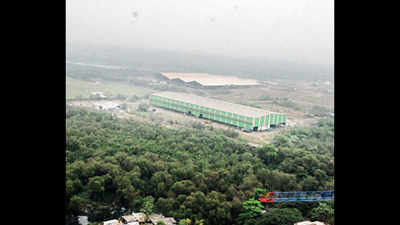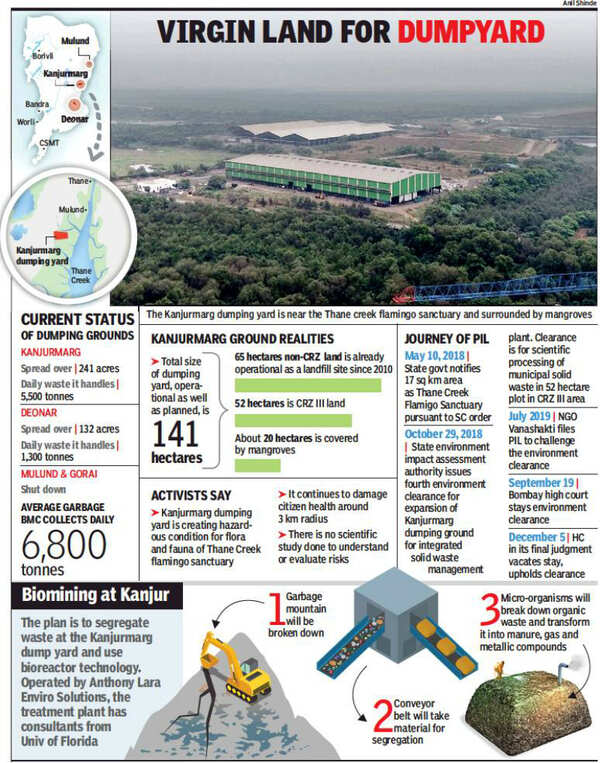- News
- City News
- mumbai News
- Bombay high court lifts stay, opens door for Kanjur waste dumpyard expansion
Trending
This story is from December 6, 2019
Bombay high court lifts stay, opens door for Kanjur waste dumpyard expansion
The Bombay high court on Thursday in an interim order vacated a stay it had granted in September on the environmental clearance for the expansion of the Kanjurmarg landfill site. The expansion is required to operate an integrated scientific solid waste management system and the environmental clearance adds 52 hectares to the 65 hectares already in use at the site.

The HC said the treatment facility at Kanjurmarg is prima facie “not in violation to CRZ notification”.
MUMBAI: The Bombay high court on Thursday in an interim order vacated a stay it had granted in September on the environmental clearance for the expansion of the Kanjurmarg landfill site. The expansion is required to operate an integrated scientific solid waste management system and the environmental clearance adds 52 hectares to the 65 hectares already in use at the site.
The state had allotted BMC over 141 hectares for waste management as an alternative to the former Chincholi Bunder landfill and the Deonar dump, which is scheduled to be closed by December 31.

A bench of Justice S C Dharmadhikari and Justice Riyaz Chagla held that “any reduction in capacity at Kanjur site would have an adverse effect on entire waste disposal scenario in Mumbai and in turn cause serious health hazards for citizens…the overriding public interest and concerns of public health and safety demand that this huge waste generated in Mumbai city and suburbs is collected and treated daily.”
Environmental activist group Vanashakti had on October 29, 2018, challenged the clearance granted by the state-level environment impact assessment authorities.
Gayatri Singh, counsel for the NGO, argued that it was against the coastal zone regulation (CRZ) rules and would adversely impact mangroves and inter-tidal areas around the Thane creek flamingo sanctuary. She also argued that it breached the Supreme Court order of a 10 km eco-sensitive zone around the peripheries of national parks and wild-life sanctuaries such as the flamingo sanctuary.
The high court bench, vacating the stay, said “its continuation was not justified”, pending final disposal of the PIL.
“It would be in larger public interest that such facility is operated to treat solid waste,” said the bench, adding that the CRZ rules expressly permitted such facility for waste treatment in the CRZ III area.
The lifting of the stay was “imperative” said the high court, especially after noting that the BMC was having to send 1,000 tonnes of waste to Deonar since the September order even though the scientific treatment facility operated by Anthony Lara Enviro Solutions was functioning for months after getting the clearance.
The Mulund dumping ground is already closed and the stay order meant reduction in scientific waste processing at Kanjurmarg site by 1,000 tonnes per day, said BMC counsel Anil Sakhare.
The city sends almost 7,000 tonnes of waste daily to the Deonar and Kanjurmarg sites, of which 5,500 is handled at Kanjur.
Milind Sathe, counsel for Anthony Lara Enviro Solutions, argued that the state clarified that the site for the scientific processing facility did not fall within or under the flamingo sanctuary or the eco-sensitive zones. He also pointed out that the environmental clearance was the fourth such nod. The first was in 2009 for the Windrows facility to dispose wet waste for 65 hectares, the second was in 2011 for a bio-reactor technology and expansion to handle 7,500 tonnes per day while the third was a CRZ clearance for the bio-reactor. All three clearances have been challenged since 2010 and none have been stayed, even by the SC, he said.
The state notified draft eco-sensitive zones last November, which ranges from 900 metres to 3.5 km around the sanctuary periphery, the court was informed, which Singh argued was wrong.
The stay was passed when the high court did not have the benefit of hearing submissions of all the parties, said the order.
The high court found “no arbitrariness” in the fourth clearance and said that the treatment facility is prima facie “not in violation to the CRZ notification”.
“The CRZ notification expressly permits under Clause 3 (v) such facility being set up in the CRZ III area for treatment of waste and effluents arising from hotels, beach resorts and human settlements located in the CRZ areas other than CRZ I and disposal of treated wastes and effluents. This is an exception to the prohibited activities within CRZ,’’ the high court ruling said.
The state had allotted BMC over 141 hectares for waste management as an alternative to the former Chincholi Bunder landfill and the Deonar dump, which is scheduled to be closed by December 31.

A bench of Justice S C Dharmadhikari and Justice Riyaz Chagla held that “any reduction in capacity at Kanjur site would have an adverse effect on entire waste disposal scenario in Mumbai and in turn cause serious health hazards for citizens…the overriding public interest and concerns of public health and safety demand that this huge waste generated in Mumbai city and suburbs is collected and treated daily.”
It added that “any obstacle in treatment at a plant specifically set up would be hazardous. In fact, untreated waste is detrimental to public health.”
Environmental activist group Vanashakti had on October 29, 2018, challenged the clearance granted by the state-level environment impact assessment authorities.
Gayatri Singh, counsel for the NGO, argued that it was against the coastal zone regulation (CRZ) rules and would adversely impact mangroves and inter-tidal areas around the Thane creek flamingo sanctuary. She also argued that it breached the Supreme Court order of a 10 km eco-sensitive zone around the peripheries of national parks and wild-life sanctuaries such as the flamingo sanctuary.
The high court bench, vacating the stay, said “its continuation was not justified”, pending final disposal of the PIL.
“It would be in larger public interest that such facility is operated to treat solid waste,” said the bench, adding that the CRZ rules expressly permitted such facility for waste treatment in the CRZ III area.
The lifting of the stay was “imperative” said the high court, especially after noting that the BMC was having to send 1,000 tonnes of waste to Deonar since the September order even though the scientific treatment facility operated by Anthony Lara Enviro Solutions was functioning for months after getting the clearance.
The Mulund dumping ground is already closed and the stay order meant reduction in scientific waste processing at Kanjurmarg site by 1,000 tonnes per day, said BMC counsel Anil Sakhare.
The city sends almost 7,000 tonnes of waste daily to the Deonar and Kanjurmarg sites, of which 5,500 is handled at Kanjur.
Milind Sathe, counsel for Anthony Lara Enviro Solutions, argued that the state clarified that the site for the scientific processing facility did not fall within or under the flamingo sanctuary or the eco-sensitive zones. He also pointed out that the environmental clearance was the fourth such nod. The first was in 2009 for the Windrows facility to dispose wet waste for 65 hectares, the second was in 2011 for a bio-reactor technology and expansion to handle 7,500 tonnes per day while the third was a CRZ clearance for the bio-reactor. All three clearances have been challenged since 2010 and none have been stayed, even by the SC, he said.
The state notified draft eco-sensitive zones last November, which ranges from 900 metres to 3.5 km around the sanctuary periphery, the court was informed, which Singh argued was wrong.
The stay was passed when the high court did not have the benefit of hearing submissions of all the parties, said the order.
The high court found “no arbitrariness” in the fourth clearance and said that the treatment facility is prima facie “not in violation to the CRZ notification”.
“The CRZ notification expressly permits under Clause 3 (v) such facility being set up in the CRZ III area for treatment of waste and effluents arising from hotels, beach resorts and human settlements located in the CRZ areas other than CRZ I and disposal of treated wastes and effluents. This is an exception to the prohibited activities within CRZ,’’ the high court ruling said.
End of Article
FOLLOW US ON SOCIAL MEDIA










